Tour Highlights
-
 The most famous nightclub in Cuba is located in the outskirts of Havana. Many legendary figures of the 20th century have performed here, including Josephine Baker and Nat King Cole. The Tropicana was originally a farm estate which was transformed in the 1930s into a vast nightspot with a restaurant and casino opening on December 31st, 1939. At the main entrance is the Fountain of the Muses (1952) and the statue of a ballet dancer, by Rita Longa (1959) is now the symbol of the club.
The most famous nightclub in Cuba is located in the outskirts of Havana. Many legendary figures of the 20th century have performed here, including Josephine Baker and Nat King Cole. The Tropicana was originally a farm estate which was transformed in the 1930s into a vast nightspot with a restaurant and casino opening on December 31st, 1939. At the main entrance is the Fountain of the Muses (1952) and the statue of a ballet dancer, by Rita Longa (1959) is now the symbol of the club. -
 This gem of Eclecticism opened in 1930 and became famous for excellent service and a long list of illustrious guests such as Nat King Cole, Winston Churchill, Frank Sinatra, Walt Disney, Marlon Brando, and several American Mafiosi as Meyer Lansky, Lucky Luciano. It stands where in the 18th Century the Santa Clara Battery was emplaced, part of the old city´s defense system, of which two cannons remain in the hotel´s garden. It was declared in 1998 as National Monument.
This gem of Eclecticism opened in 1930 and became famous for excellent service and a long list of illustrious guests such as Nat King Cole, Winston Churchill, Frank Sinatra, Walt Disney, Marlon Brando, and several American Mafiosi as Meyer Lansky, Lucky Luciano. It stands where in the 18th Century the Santa Clara Battery was emplaced, part of the old city´s defense system, of which two cannons remain in the hotel´s garden. It was declared in 1998 as National Monument. -
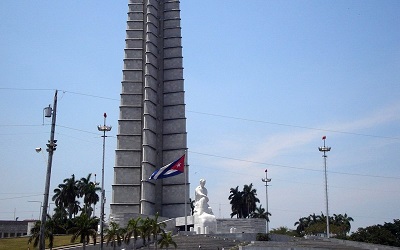 This construction was conceived in 1953 as Civic Square, on the 100th anniversary of the Cuban national hero´s birth and finished in 1959 when it was renamed as Revolution Square. It consists of a 142 meters tower representing a five pointed star and a huge statue of José Martí whose Memorial is in the interior of the base. Since 1959 it has been Cuba´s political and administrative center and the main venue for political rallies and official celebrations. Pope John Paul II in 1998 and Pope Benedicto XVI in 2012 celebrated masses together with thousands of worshipers.
This construction was conceived in 1953 as Civic Square, on the 100th anniversary of the Cuban national hero´s birth and finished in 1959 when it was renamed as Revolution Square. It consists of a 142 meters tower representing a five pointed star and a huge statue of José Martí whose Memorial is in the interior of the base. Since 1959 it has been Cuba´s political and administrative center and the main venue for political rallies and official celebrations. Pope John Paul II in 1998 and Pope Benedicto XVI in 2012 celebrated masses together with thousands of worshipers. -
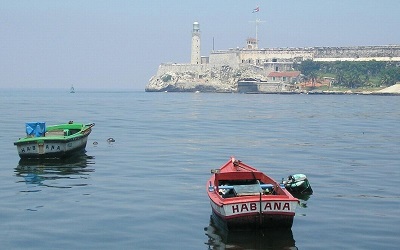 Construction
of this fortress was designed by Bautista Antonelli and built between
1589 and 1630. The original lighthouse was rebuilt many times, the one
that still stands today is from 1845 and has its original lamp. Havana
was a highly prized target for enemies and pirates for its extremely
favorable strategic position in the Caribbean and became the most
fortified city in any Spanish colony. It was declared a UNESCO site as
part of the city´s defense system along with other fortresses as
La Cabaña, La Real Fuerza, La Punta, etc.
Construction
of this fortress was designed by Bautista Antonelli and built between
1589 and 1630. The original lighthouse was rebuilt many times, the one
that still stands today is from 1845 and has its original lamp. Havana
was a highly prized target for enemies and pirates for its extremely
favorable strategic position in the Caribbean and became the most
fortified city in any Spanish colony. It was declared a UNESCO site as
part of the city´s defense system along with other fortresses as
La Cabaña, La Real Fuerza, La Punta, etc. -
 It was designed by Belgian architect Paul Belau to host the social activities of Havana´s large and affluent Spanish community. The magnificent façade is decorated with four sculpture groups depicting Charity, Education, Music and Theater. It was built over the foundations of the Tacón Theater which opened on November 1837. The present building was inaugurated on 1915 and has witnessed world famous artist as Fanny Essler, Verdi, Sarah Bernhardt, Arthur Rubinstein, Anna Pavlova and Alicia Alonso, etc. Today, it houses the National Ballet of Cuba.
It was designed by Belgian architect Paul Belau to host the social activities of Havana´s large and affluent Spanish community. The magnificent façade is decorated with four sculpture groups depicting Charity, Education, Music and Theater. It was built over the foundations of the Tacón Theater which opened on November 1837. The present building was inaugurated on 1915 and has witnessed world famous artist as Fanny Essler, Verdi, Sarah Bernhardt, Arthur Rubinstein, Anna Pavlova and Alicia Alonso, etc. Today, it houses the National Ballet of Cuba. -
 The Cuban
Capitol, Inaugurated on May 20th, 1929 was the seat of the House of
Representatives and the Senate until 1959. It marks the 0 kilometer of
Cuba’s highways system. Its almost 92 meters high dome, the Chamber of
Deputies, the Hall of Lost Steps and the statue “the Republic”, made by
the Italian artist Angelo Zanelli, the third largest indoor statue in
the world are among its many attractions. Today, it houses the Ministry
of Science, Technology and Environment.
The Cuban
Capitol, Inaugurated on May 20th, 1929 was the seat of the House of
Representatives and the Senate until 1959. It marks the 0 kilometer of
Cuba’s highways system. Its almost 92 meters high dome, the Chamber of
Deputies, the Hall of Lost Steps and the statue “the Republic”, made by
the Italian artist Angelo Zanelli, the third largest indoor statue in
the world are among its many attractions. Today, it houses the Ministry
of Science, Technology and Environment. -
 Ernest Hemingway’s favorite place to enjoy his daiquiri. In 1953 it was
considered one of the seven most famous bars in the world, and in 1992,
the American Academy of Gastronomical Science presented the Floridita
with the Best of the Best Five Star Diamond Award. Kwon as the “cradle
of the Daiquiri”, it still keeps its original Regency décor from 1950s.
Ernest Hemingway’s favorite place to enjoy his daiquiri. In 1953 it was
considered one of the seven most famous bars in the world, and in 1992,
the American Academy of Gastronomical Science presented the Floridita
with the Best of the Best Five Star Diamond Award. Kwon as the “cradle
of the Daiquiri”, it still keeps its original Regency décor from 1950s. -
 The hustle
and bustle at San Francisco Square bothered religious services at the
Basilica. The Franciscan fathers requested the creation of a square for
exclusive commercial use, named New Square. After the creation of other
urban areas in the 19th century it lost its initial name becoming Old
Square. Cristina Market was built in the center in honor of the Queen,
being demolished in 1908. Administrative and business offices sprang up
with the 20th Century and a small amphitheater with a parking lot
beneath were built in 1952 which are no longer part of this square after
its restoration.
The hustle
and bustle at San Francisco Square bothered religious services at the
Basilica. The Franciscan fathers requested the creation of a square for
exclusive commercial use, named New Square. After the creation of other
urban areas in the 19th century it lost its initial name becoming Old
Square. Cristina Market was built in the center in honor of the Queen,
being demolished in 1908. Administrative and business offices sprang up
with the 20th Century and a small amphitheater with a parking lot
beneath were built in 1952 which are no longer part of this square after
its restoration. -
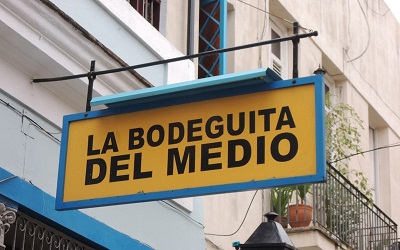 A very well-known bar where Hemingway loved to drink mojitos and a one of the city’s great tourist attractions, where countless visitors have left their imprint in a souvenir, a photo or on its graffiti covered walls. Here you will find signatures by Errol Flynn, Nat King Cole, Ernest Hemingway, Pablo Neruda, Gabriel García Márquez, Alejo Carpentier and Nicolás Guillen, among many others.
A very well-known bar where Hemingway loved to drink mojitos and a one of the city’s great tourist attractions, where countless visitors have left their imprint in a souvenir, a photo or on its graffiti covered walls. Here you will find signatures by Errol Flynn, Nat King Cole, Ernest Hemingway, Pablo Neruda, Gabriel García Márquez, Alejo Carpentier and Nicolás Guillen, among many others. -
 It was
originally known as Swamp Square because of the marshy land and
subterranean springs. A church built by the Jesuit order (1748-1776) was
promoted to the status of cathedral 1789, thus the original plaza
became Cathedral Square. Some aristocratic buildings appeared later as
Lombillo, Marquis of Aguas Claras and Marquis of Arcos palaces. The
cathedral´s Baroque façade is grandiose with two large asymmetrical
towers and its neoclassical interior treasures frescoes by Italian
Giovani Perovani and Jean Baptiste Vermay. Pope John Paul II visited it
in 1998.
It was
originally known as Swamp Square because of the marshy land and
subterranean springs. A church built by the Jesuit order (1748-1776) was
promoted to the status of cathedral 1789, thus the original plaza
became Cathedral Square. Some aristocratic buildings appeared later as
Lombillo, Marquis of Aguas Claras and Marquis of Arcos palaces. The
cathedral´s Baroque façade is grandiose with two large asymmetrical
towers and its neoclassical interior treasures frescoes by Italian
Giovani Perovani and Jean Baptiste Vermay. Pope John Paul II visited it
in 1998. -
 Its location
made it the center of imports, export, sailors and troops disembarking.
The construction of a humble Franciscan convent, later one of the most
beautiful buildings in the area, gave its name to the open space. The
Fountain of the Lions, donated by Villanueva Count in 1836 and sculpted
in Carrara marble, supplied for many years the ships docked here with
drinking water. The Stock Exchange (1909) and the Customs House (1914)
were added to the physiognomy of the square.
Its location
made it the center of imports, export, sailors and troops disembarking.
The construction of a humble Franciscan convent, later one of the most
beautiful buildings in the area, gave its name to the open space. The
Fountain of the Lions, donated by Villanueva Count in 1836 and sculpted
in Carrara marble, supplied for many years the ships docked here with
drinking water. The Stock Exchange (1909) and the Customs House (1914)
were added to the physiognomy of the square. -
 Neoclassic
monument inaugurated in 1828 as a remembrance to the foundation of Saint
Christopher of Havana. It stands where there was a silk-cotton tree,
under whose shadow the first Mass and city council were held on November
16th, 1519. Inside, there are three canvases by Jean Baptiste Vermay
depicting these scenes. Every year on November 16th, locals would circle
the tree three times, knock on its trunk three times and ask for their
wishes as part of a town tradition.
Neoclassic
monument inaugurated in 1828 as a remembrance to the foundation of Saint
Christopher of Havana. It stands where there was a silk-cotton tree,
under whose shadow the first Mass and city council were held on November
16th, 1519. Inside, there are three canvases by Jean Baptiste Vermay
depicting these scenes. Every year on November 16th, locals would circle
the tree three times, knock on its trunk three times and ask for their
wishes as part of a town tradition. -
 This
seafront promenade runs for 7 km alongside the city´s historic quarters,
from the colonial center to the skyscrapers of El Vedado. This busy
boulevard is lined with many attractive buildings whose pastel hues have
faded in the sun and salty air. It is magical at sunset, popular among
fishermen, and the perfect place for people to hang out, meet friends
and socialize.
This
seafront promenade runs for 7 km alongside the city´s historic quarters,
from the colonial center to the skyscrapers of El Vedado. This busy
boulevard is lined with many attractive buildings whose pastel hues have
faded in the sun and salty air. It is magical at sunset, popular among
fishermen, and the perfect place for people to hang out, meet friends
and socialize. -
 This
fortress was built in 1558-1577 to protect the city from pirate attacks
and is the oldest military construction in Havana. Despite its perfect
Renaissance architecture, it couldn´t be efficient as it was built too
far inside the bay, in a low area. It was used as warehouse, Governor´s
residence, barracks, National Archive, Army Headquarters, National
Library, and Arms Museum, etc. The Giraldilla, a sculpture cast in
bronze by Havana artist Jerónimo Martínez Pinzón was placed as a weather
vane on top of the Northwest tower in the 1630s and became a city´s
symbol.
This
fortress was built in 1558-1577 to protect the city from pirate attacks
and is the oldest military construction in Havana. Despite its perfect
Renaissance architecture, it couldn´t be efficient as it was built too
far inside the bay, in a low area. It was used as warehouse, Governor´s
residence, barracks, National Archive, Army Headquarters, National
Library, and Arms Museum, etc. The Giraldilla, a sculpture cast in
bronze by Havana artist Jerónimo Martínez Pinzón was placed as a weather
vane on top of the Northwest tower in the 1630s and became a city´s
symbol. -
 The Central
Plaza was built in 1877 after the old city walls were demolished. Since
February 1905, its large esplanade is presided by a statue of José
Martí, which replaced a marble statue of Isabel II of Spain. The Central
Plaza is surrounded by significant buildings, such as the Grand Theater
of Havana, the Inglaterra, Telégrafo, Plaza and Parque Central Hotels,
the old Gómez Mena mall, the Universal Art building of the Fine Arts
National Museum and the Payret Movie Theater.
The Central
Plaza was built in 1877 after the old city walls were demolished. Since
February 1905, its large esplanade is presided by a statue of José
Martí, which replaced a marble statue of Isabel II of Spain. The Central
Plaza is surrounded by significant buildings, such as the Grand Theater
of Havana, the Inglaterra, Telégrafo, Plaza and Parque Central Hotels,
the old Gómez Mena mall, the Universal Art building of the Fine Arts
National Museum and the Payret Movie Theater. -
 Cuba´s first motion picture theater, opened in 1897, a year after the Lumiere brothers presented their invention in Paris.
Cuba´s first motion picture theater, opened in 1897, a year after the Lumiere brothers presented their invention in Paris. -
 It houses today the Museum of Havana´s Pharmacies. The institution presents the history of this science in Cuba through permanent exhibits distributed in three large rooms. It still preserves the old drugstore´s furniture, medicine bottles and other items related to the art of curing and prescribing.
It houses today the Museum of Havana´s Pharmacies. The institution presents the history of this science in Cuba through permanent exhibits distributed in three large rooms. It still preserves the old drugstore´s furniture, medicine bottles and other items related to the art of curing and prescribing. -
 The
residence of 22 Cuban presidents since 1920 until 1959 was designed by
Carlos Maruri and Paul Belau and decorated by Teffany of New York. The
museum features documents, photographs of the different historical
processes in Cuba. The Granma Memorial treasures the boat which brought
Fidel Castro and his comrades from Mexico to begin the armed struggle
against Batista. There also objects and vehicles relating to the
invasion of the Bay of Pigs and missile crisis, etc.
The
residence of 22 Cuban presidents since 1920 until 1959 was designed by
Carlos Maruri and Paul Belau and decorated by Teffany of New York. The
museum features documents, photographs of the different historical
processes in Cuba. The Granma Memorial treasures the boat which brought
Fidel Castro and his comrades from Mexico to begin the armed struggle
against Batista. There also objects and vehicles relating to the
invasion of the Bay of Pigs and missile crisis, etc. -
 Havana’s
monumental Cemetery, built in (1871-1886), is one of the largest in the
world, occupying an area of 57 hectares. Because of its many sculptures
and monuments from eclectic to contemporary art, the Necropolis was
proclaimed a National Monument in 1987. It was designed by Calixto de
Loira as a Roman military camp. The statue in Carrara marble of the
three theological virtues Faith, Hope and Charity which crowns the front
gate was sculpted in 1904 by the Cuban artist José Villalta de
Saavedra. The most visited grave, “The Miraculous one”, is the tomb of
Amelia Goyri de la Hoz who became a protector of pregnant women and
newborn children.
Havana’s
monumental Cemetery, built in (1871-1886), is one of the largest in the
world, occupying an area of 57 hectares. Because of its many sculptures
and monuments from eclectic to contemporary art, the Necropolis was
proclaimed a National Monument in 1987. It was designed by Calixto de
Loira as a Roman military camp. The statue in Carrara marble of the
three theological virtues Faith, Hope and Charity which crowns the front
gate was sculpted in 1904 by the Cuban artist José Villalta de
Saavedra. The most visited grave, “The Miraculous one”, is the tomb of
Amelia Goyri de la Hoz who became a protector of pregnant women and
newborn children. -
 This
charming hotel from 1923, eclectically decorated, is rich in literary
memories. The American writer Ernest Hemingway stayed here for long
periods during the 1930´s writing fishing chronicles and began to write
his novel For Whom the Bell Tolls. Room 511, where he mostly stayed is
now a museum that features personal belongings and pictures of the
author.
This
charming hotel from 1923, eclectically decorated, is rich in literary
memories. The American writer Ernest Hemingway stayed here for long
periods during the 1930´s writing fishing chronicles and began to write
his novel For Whom the Bell Tolls. Room 511, where he mostly stayed is
now a museum that features personal belongings and pictures of the
author. -
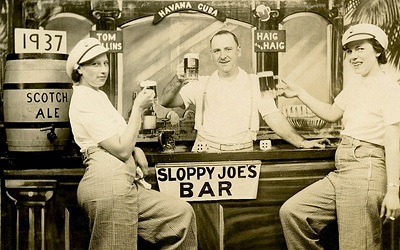 Sloppy Joe's was a spectacular Havana bar in the 30's. Ernest Hemingway was a regular with his pal, Joe Russell who was the owner of another Sloppy Joe's Bar in Cayo Hueso, a name Hemingway had suggested in honor to Mr. Garcia, the owner, who ran his business very messy and careless at first, hence the name of Sloppy Joe. A sandwich served here, made of shredded beef "ropa vieja”, was worldwide known as Sloppy Joe´s. It was also a very popular place for having the longest mahogany drinks cabinet of Cuba.
Sloppy Joe's was a spectacular Havana bar in the 30's. Ernest Hemingway was a regular with his pal, Joe Russell who was the owner of another Sloppy Joe's Bar in Cayo Hueso, a name Hemingway had suggested in honor to Mr. Garcia, the owner, who ran his business very messy and careless at first, hence the name of Sloppy Joe. A sandwich served here, made of shredded beef "ropa vieja”, was worldwide known as Sloppy Joe´s. It was also a very popular place for having the longest mahogany drinks cabinet of Cuba. -
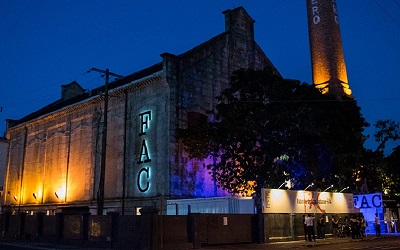 Fábrica de Arte Cubano is one of Havana’s finest new art projects, an interactive place for live music, art expos, fashion shows. This converted cooking-oil factory in Vedado founded by Cuban fusion musician X-Alfonso in 2014 is a cultural-social project which aims at supporting and promoting young artists work from all art expressions such as cinema, music, dance, theatre, plastic arts, literature, photography, fashion and graphic design.
Fábrica de Arte Cubano is one of Havana’s finest new art projects, an interactive place for live music, art expos, fashion shows. This converted cooking-oil factory in Vedado founded by Cuban fusion musician X-Alfonso in 2014 is a cultural-social project which aims at supporting and promoting young artists work from all art expressions such as cinema, music, dance, theatre, plastic arts, literature, photography, fashion and graphic design.

 1
1 2
2 3
3 4
4 5
5 6
6 7
7 8
8 9
9 10
10 11
11 12
12 13
13 14
14 15
15 16
16 18
18 19
19 20
20 21
21 22
22 23
23








